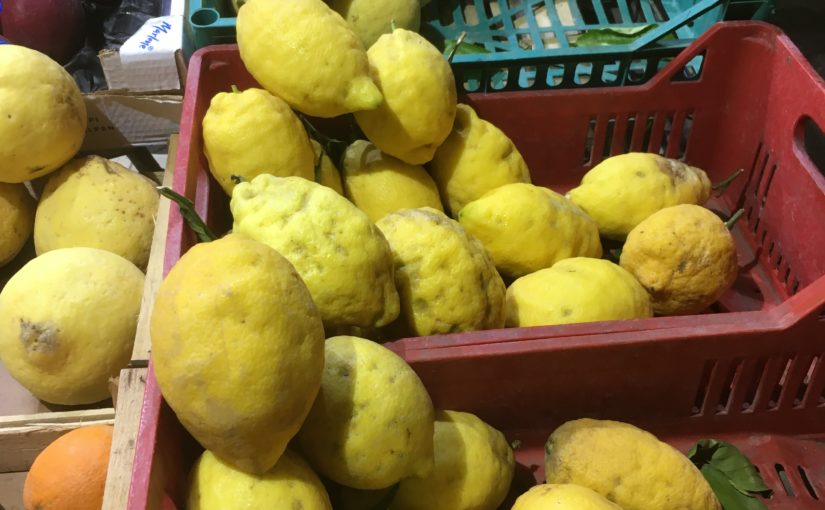Dear reader,
This morning, I took my last exam. Classes are drawing to a close, and that means my time in Italy is almost over. I wanted to write to you all one last time before I leave, and so I now present the post you have all been waiting for: the one about Italian food. (If you are reading on an empty stomach, proceed at your own risk.)
First, the structure of meals in Italy is different from the United States. The main meal is traditionally lunch, and dinner is eaten late in the evening. Breakfast is small and sweet. A common breakfast item is the “cornetto”, which is a croissant-like pastry with jam or cream filling.
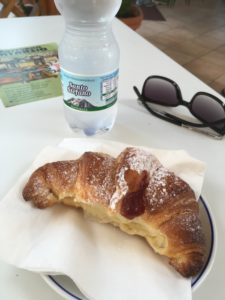
Then there is lunch. A full Italian-style lunch is five courses: “antipasto” (appetizer), “primo piatto” (usually pasta), “secondo piatto” (something more substantial like meat or fish), “contorno” (side dish, like soup or salad), “dolce” (dessert or fruit) with coffee and after-dinner alcohol. Of course, there is before-dinner alcohol and during-dinner alcohol as well, but in moderate amounts. Dinner is much later, and is supposed to be lighter, like vegetables or pizza. (Yes, pizza. Apparently it’s considered a light meal here.)
Now, before I proceed any further, I would like to say that I have not been eating a three-hour, five-course lunch every day here. In fact, I haven’t done it even once. That is because one essential ingredient to these long lunches is other Italians, one’s friends and family, with whom to eat. Since I’m living in the dorm, not a host family, I have not had the opportunity to have a big family dinner.
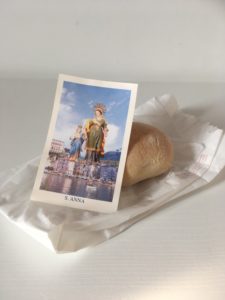
Furthermore, I have serious doubts that the Italians have elaborate meals like this every day. However, all my information about Italian meals is second-hand, and living in a tourist area probably changes the rhythm of Italian life anyway. I can only say that the above description is supposed to be the “traditional” way of doing it.
In reality, I have cooked most of my meals for myself. This was one of the most surprising, challenging, and rewarding parts of the trip for me. I had to learn how to meal plan, navigate a supermarket (in Italian), and cook something other than scrambled eggs. Furthermore, I thought that since I was in Italy, I might as well try to cook Italian. I tried emulating some of my favorite pasta dishes, and used the Internet to supplement my ignorance.
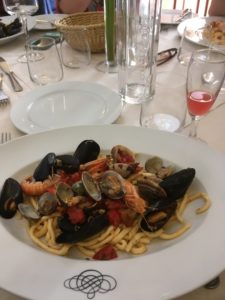
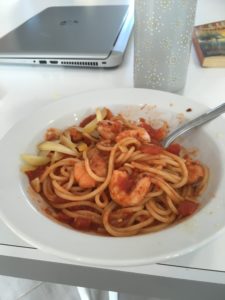
Sometimes, my dishes turned out really well. At other times, I thanked heaven that I was cooking only for myself, since it meant that I was the only one to suffer from the watery-cheese-sauce disaster. Still, increased confidence in the kitchen was not a benefit I was expecting from this trip. I am pleasantly surprised to find that I have learned a lot about how to shop and cook like an independent adult.
One challenge of cooking for myself was that the food in Italy, although it is not totally foreign, is still different from American food. While the food in Italy is generally fresher, there is less variety. There is a whole aisle in the supermarket just for pasta noodles, and another half-aisle just for bottled tomato sauce. There is salami, prosciutto, pancetta, and sausage, but no ground beef, and certainly no plain-old sandwich meat. The eggs are processed differently and so are not refrigerated (which hasn’t stopped me from keeping my eggs in the fridge out of sheer habit). Peanut butter is an expensive specialty item. These are little differences, but they were very surprising at first.
Then there are the specialty stores. The two most common kinds are fruit stands and “salumerias”.
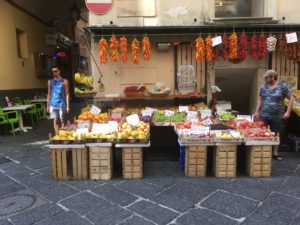
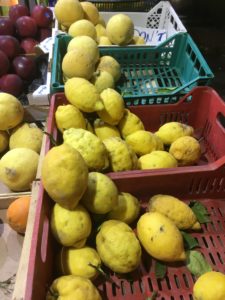
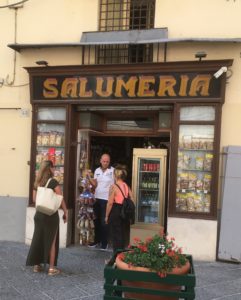
A salumeria is basically a deli. They sell meat and cheese, but often have pasta and wine as well. To tell the truth, I did not use these stores very often. I learned first hand why supermarkets have a corner on the grocery market: they are cheap, and it is very convenient to buy all your groceries in one place.
From time to time, I would go out to a restaurant with my friends here. This would inevitably mean pizza or pasta. (I believe it is impossible to overstate the prevalence of pasta in Italy. It is not just a stereotype.)
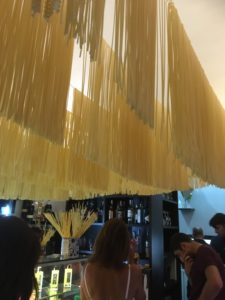
Being next to the ocean means amazing seafood pastas. Being next to Naples, the birthplace of pizza, means amazing pizzas. Everything I ate at restaurants was very simple and very good.
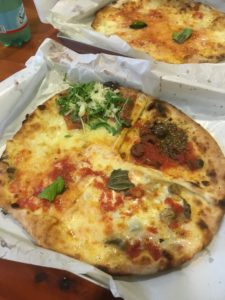
Going out to restaurants, we also learned a few Italian customs. First, restaurants do not provide separate bills. This means that, when we go out to eat, one person will pay for the group and everyone else will pay them back. Second, sitting down to a meal is much more expensive than getting take-away. Space is valuable in Italy, so if you want a table, you have to pay for it. Furthermore, it is not customary to tip your waiter, so the service fee is also included in the “coperta”, or cover charge. Thirdly, the restaurant will not bring you your bill until you ask for it. After all, you paid for the table, and so you can linger for a long time if you want. This allows the Italians to enjoy long talks with friends over a meal.
Coffee is almost as much of a staple as pasta. On our tour of the Amalfi coast, the guide said that Italians will drink coffee four times a day. However, when an Italian thinks “coffee”, he or she does not think Starbucks. In fact, I don’t think there is a single Starbucks in Sorrento. “Coffee” means espresso, either a plain shot or mixed with milk. There are cafes everywhere, but I’ve gotten most of my coffee from a machine in the dorm that would make Willy Wonka proud. You insert a coin, select a drink, and wait. Meanwhile, the machine produces a cup, adds sugar, heats and froths milk, adds a shot of espresso, and gives you the finished product complete with a little stir stick. In America, I would be highly skeptical of any “machine coffee.” Not in Italy. Even their machine-made espresso is delicious.
Finally, there are the sweets. I believe that pictures will make the point more eloquently than words.
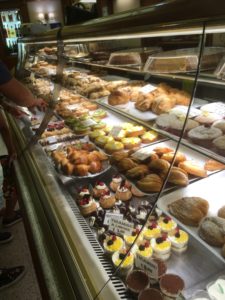
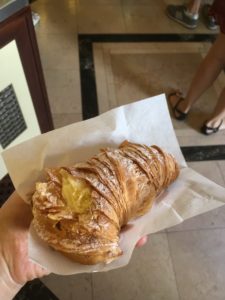
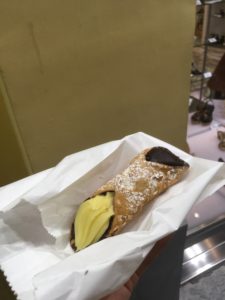
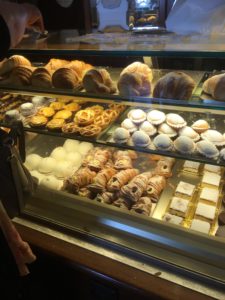
There is, of course, gelato as well. Sorrento knows its tourists, and so there is a gelateria about every block or so. The best gelato has only a few ingredients and is always made fresh every day. I made it a goal to find my favorite gelateria, and I narrowed it down to two. They are both small, local shops with unique flavors (such as honeycomb or fig).

As one last note, you may be surprised to hear that living in Italy has made me appreciate American cooking more. All the Italians to whom I have talked say that America does some food really well: steak, cheesecake, and bagels are good examples. Furthermore, the variety that we have in America is incredible. Although we Americanize every cuisine we touch, we still have everything from Greek to Mexican to Chinese.
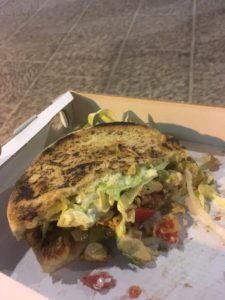
So there you have it. This will be my last blog post from Italy; however, I will write one more once I get back to the States to review and sum up my experiences. As always, thank you for accompanying me.
Until next time,
Beatrice
